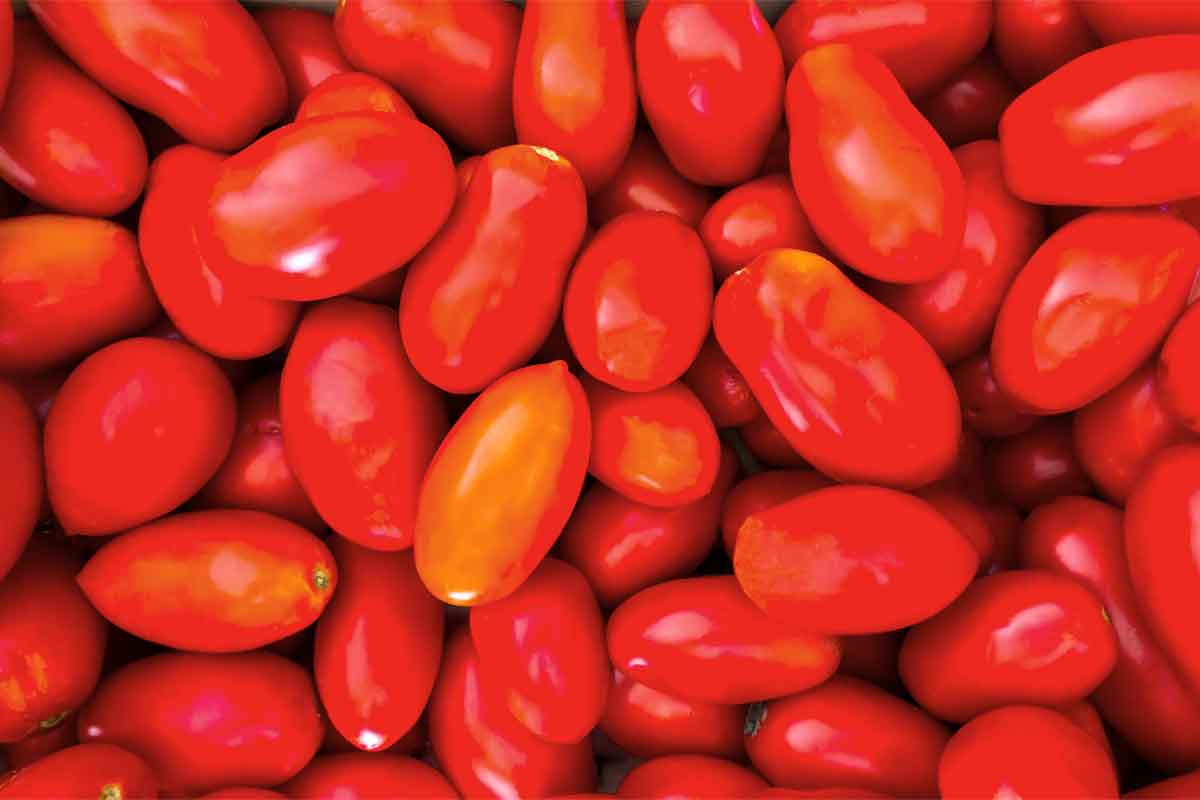

You’ve heard of San Marzano tomatoes. You’ve seen San Marzano tomatoes. And maybe you’ve even tried San Marzano tomatoes. But do you know why San Marzano tomatoes are accorded such reverence and adoration?
What’s in a name?
Much like Champagne, Parmigiano Reggiano cheese, and Black Forest ham, San Marzano tomatoes get their name from the area they come from and are given a Protected Designation of Origin, the European Union’s stamp of authenticity. In the simplest terms, this means anything labeled San Marzano tomatoes can only come from San Marzano, Italy. These little beauties are sold only in cans, whether whole or cut in half. If your tomatoes come in a jar or are pureed, chopped, diced, or even labeled organic, they aren’t the real thing.
There has been a flurry of news coverage about faux San Marzanos; it’s a small region that can only produce so much, and they fetch a higher price than any other tomato product. Their reputation for being the best has inspired others to grow fakes that are close but…not quite. Plum tomatoes grown nearby, but not actually in, San Marzano will taste and look similar but haven’t been given that specific designation–the all-important words “Pomodoro San Marzano dell’Angro Sarnese Nocerino.” If in doubt, check the can—true San Marzanos will always have the D.O.P. designation (see above) and state where they came from.
What makes San Marzano tomatoes so special?
In part, it’s where they’re from. San Marzano sul Sarno isn’t far from Naples, which is considered by some to be the home of the world’s best pizza, and those powerhouse plum tomatoes have a lot to do with it. This specific variety of plum tomato grows in the rich volcanic soil of the Sarno River valley, near Mount Vesuvius, giving them a sweet taste and a lower acidity.
Similar to a Roma tomato, San Marzanos are meatier with very few seeds and a thick skin that’s easy to peel. All of these things make them ideal for a full-flavored, tomato focused sauce or a classic Neapolitan pizza sauce (made with just tomatoes and salt…seriously).
Can I grow my own San Marzano tomatoes?
Want to Save This?
Technically, anyone can grow San Marzanos nearly anywhere in the world. And they’ll still be good. San Marzanos grown stateside are incredibly delicious; they’re just a little tangier and less richly sweet than the ones grown at the base of Mount Vesuvius.
Which brand should I buy?
Search San Marzano online or mention them to a few of your food-wise friends, and you’ll quickly get an idea of the divisiveness surrounding the topic. Celeb chef Alton Brown has been outspoken in his fevered infatuation with the canned lovelies, while others will tell you that they’re not worth the hype. There are dozens of taste tests you can read about online to help you find a brand that will get you the exact shade of sweet tomatoey goodness that you deserve.
The New York Times published their taste test findings based on “color, flavor, sweetness, acidity, overall appearance and texture,” and challenged the notion of “the San Marzano tomato, grown in Italy, as the ideal.” They included several San Marzano-style tomatoes and even San Marzano tomatoes grown stateside. And the results surprised even them.
Americans’ pomodoro preference
So where does this leave you? It would seem that the American palate prefers San Marzano tomatoes that aren’t grown in San Marzano. In general, we prefer tomatoes that are less sweet and have a brighter, tangier taste. The other thing Americans want? Salt. Salted tomatoes consistently score higher than unsalted.
But if all the other kids jumped off a cliff, would you? Go with what works for you. If you’ve always been curious about those fancy cans of Italian lovelies, it might be time for you to finally try them. Preferably in the simplest incarnations, you can imagine, whether an incredible spicy tomato soup, a traditional Bolognese, or an easy pizza sauce. Let us know what you think.










I am a tomato fiend, and I love San Marzano DOP tomatoes. Every brand that I have tried has been eclipsed by an American brand. I’m reluctant to disclose it, because the price is rising fast due to demand, and it can be hard to find (look at a store sometimes referred to as whole paycheck). But here goes: DiNapoli Whole Peeled Tomatoes and DiNapoli Crushed Tomatoes. Organic California tomatoes. San Marzano upstaged, totally. And I’ve created some good Karma for myself for sharing.
You sure have, Russ! Thanks so much for sharing.